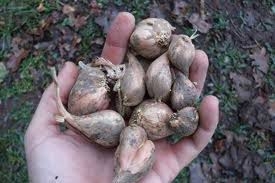
Shallots have been a favored ingredient of good cooks for centuries. Thought to have originated in Central or Southeast Asia, they migrated into India and the eastern Mediterranean before being widely dispersed around the world.
The word "shallot" comes from the name of the ancient Philistine city of Ashkelon, which is where early Greeks believed the plant originated. Today, regional varieties are prized in cuisines as diverse as French, Thai and Indian.
Most of us were familiar with the bronze-skinned shallots available at our local grocery. We were surprised to find that shallots come in a variety of shades ranging from gray, cream and bronze to pink and red. In researching sources for planting, we decided to try two kinds: ‘French Gray' shallots, which were touted as being the variety prized by chefs, and another called ‘French Red.'
Although some gardeners have success planting shallot bulbs from the grocery store, we purchased ours from a nursery to be sure that they were disease-free. Shallots are most commonly planted from “sets,” which means that the cloves are separated from a mature bulb and planted individually. In our Mediterranean climate, autumn is the best planting time for shallots. We planted last November with the expectation that we would be harvesting late the following spring.
Shallots prefer well-drained garden soil amended with plenty of compost. The individual cloves or small bulbs should be planted about six inches apart and with the pointed end just at or below the soil surface. Because they are sensitive to overwatering, shallots do well in raised beds. However, they also grow best with about an inch of water every week. In a dry winter like we had last year, supplemental irrigation will ensure a better crop.
My garden beds are prone to gopher activity, so I planted the shallots in wire cages sunk into the ground. Because I had grown summer vegetables in the same area earlier in the year, I added a granular all-purpose organic fertilizer at planting time. The sets went into well-watered ground the week of Thanksgiving. I added a half-inch layer of compost over the planted bulbs to conserve soil moisture. The only other care they received last winter was irrigation during dry periods.
The gray shallots sprouted readily and began growing right away. I was worried about the red variety though. Only about a third of the bulbs had sprouted by January, and I was wondering if they had rotted or been consumed by some predator. Eventually the red shallots did send up sprouts, and I continued to water both red and gray types through May. By the end of May, all the shallots had formed bulbs and some of the tops started to yellow. At this point I stopped watering them and waited for most of the tops to die back. I have to admit I was impatient for the harvest, not only for the delicious shallots I was anticipating but also so that I could free up the bed for a summer crop.
By the end of June, all the Master Gardeners had harvested their shallots, and we met to discuss results. To my surprise, the late-sprouting ‘French Red' shallots produced about double the yield of the ‘French Gray,' even though all gardeners planted an equal amount of both types. The red variety produced fewer bulbs per plant, but they were larger and easier to peel. Some of them were about the size of golf balls. The grey shallots were numerous but small, the size of a thimble or a thumb. Both varieties seem to store equally well. Four months after harvest, some are softening and spoiling, but there are still quite a few shallots of both types in good shape.
I wish I could tell you which one is better for cooking, but I'm afraid my palate is not that refined. When I needed just a little shallot flavor for a salad dressing, I preferred the small grey variety. For recipes calling for larger quantities of shallots, it was easier to reach for the reds. I'm looking forward to growing both again this year.
Workshop: Napa County Master Gardeners will conduct a workshop on “Creating Wreaths from Your Garden” on Sunday, December 7, from 2 p.m. to 4 p.m., at the Yountville Community Center, 6516 Washington Street, Yountville. Learn which plants from your garden make good wreaths. Learn how to choose and prepare plant materials, and tips and tricks for designing and making easy wreaths for the holidays or other times of the year. Participants will create their own wreath to take home. To register, call the Parks & Recreation Department at 707-944-8712 or visit its website.
Master Gardeners are volunteers who help the University of California reach the gardening public with home gardening information. Napa County Master Gardeners ( http://ucanr.org/ucmgnapa/) are available to answer gardening questions in person or by phone, Monday, Wednesday and Friday, 9 a.m. to Noon, at the U. C. Cooperative Extension office, 1710 Soscol Avenue, Suite 4, Napa, 707-253-4143, or from outside City of Napa toll-free at 877-279-3065. Or e-mail your garden questions by following the guidelines on our web site. Click on Napa, then on Have Garden Questions? Find us on Facebook under UC Master Gardeners of Napa County.